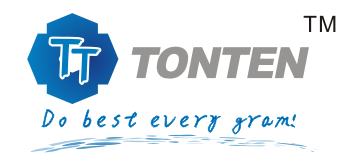
buy Phenolic Resin Granule for sand Coatings TONTEN phenol formaldehyde resin

DESCRIPTION:
TONTEN TM phenolic resins demonstrate exceptional chemical resistance. phenolic resin is yellow, transparent, amorphous bulk material, due to containing free phenol was slightly red, the actual proportion of the average 1.7 or so, soluble in alcohol, insoluble in water, water, weak acid, weak alkaline solution stability. By phenol and formaldehyde in the catalyst conditions polycondensation, by neutralization, washing and made of resin. Depending on the choice of catalyst can be divided into two types of thermosetting and thermoplastic.
CHARACTERISTICS:
Bonding Strength
The primary use of phenolic resin is as a bonding agent. Phenolic resin effortlessly penetrates and adheres to the structure of many organic and inorganic fillers and reinforcements, which makes it an ideal candidate for various end uses. A brief thermal exposure to complete the cross-linking or "thermoset" process results in attainment of final properties. The unique ability of phenolic resin to "wet out" and to cross-link throughout the fillers and reinforcements provides the means to engineer the desired mechanical, thermal, and chemically resistant properties.
Applications benefiting from the hardness, and heat and chemical resistance properties afforded phenolic resins include abrasive grinding wheels, friction linings, refractory products, and other molded parts used in high temperature or aggressive environments. For years, phenolic resin's exceptional compatibility with cellulose fillers has been used to great benefit for particleboard, plywood, hardboard, oriented strand board, substrates for melamine laminates and decking applications. Composites for demanding applications such as on oil platforms, missile components, and heat shields are produced using phenolic resins along with process technologies such as resin transfer molding (RTM), pultrusion, or filament winding.
High Temperature Performance
A key characteristic of thermoset phenolic resin is its ability to withstand high temperature under mechanical load with minimal deformation or creep. In other words, cured phenolic resin provides the rigidity necessary to maintain structural integrity and dimensional stability even under severe conditions. For this reason, phenolic resin binders meet the challenges of high temperature environments in demanding applications such as refractory, friction, foundry and aerospace products. Examples of applications that take special advantage of the dimensional stability of phenolic molding compounds are natural gas valves, automotive brake pistons, pulleys, and hydraulic and water pump housings and seals.
Chemical Resistance
Phenolic resins accommodate the harsh exposure of severe chemical environments. The inherent nature of phenolic resin provides an impervious shield to protect a variety of substrates from the corrosive effects of chemicals. Laboratory tests confirm minimal degradation from many chemicals after prolonged exposure, often at elevated temperatures. Typical exposures include gasoline, alcohol, oil, glycol, brake fluid, various hydrocarbons, and also weak acids and bases. Protective linings inside tankers used for bulk transfer of acids and other corrosive chemical products are often composed of phenolic resins.
Low Smoke and Toxicity
Burning phenolic resin typically generates hydrogen, hydrocarbons, water vapor, and carbon dioxide. Phenolic resin produces a relatively low amount of smoke at a relatively low level of toxicity. Manufacturers use phenolic resins extensively to address the safety concerns of the transportation industry. Automotive and mass transit industries choose phenolic resin for its high heat resistance and excellent flame, smoke, and toxicity properties. Another critical application is in air support systems for the mining industry and related electrical conduit supports. Phenolic resins designed to meet specific flammability ratings are available. Selective use of inorganic fillers and reinforcements often enhances protection in the event of contact with an ignition source.
High Carbon and Char Yield
Phenolic resins demonstrate higher char yields than other plastic materials when exposed to temperatures above their point of decomposition. In an inert atmosphere at high temperatures (600° - 2,000°F, 300 - 1,000°C), phenolic resin will convert to a structural carbon known as vitreous carbon. In many ways, this material behaves similar to ceramic and may actually contribute to structural integrity when exposed to fire situations. Manufacturers of structural composite gratings and pipes for offshore oilrigs, where fires are a constant threat, utilize phenolic resins for the characteristic. Phenolic resin is also useful in designing vitreous carbon articles such as special analytical electrodes, crucibles for melting rare earth metals, rocket nozzles, extremely high temperature bearings and seals, and heat shields for missiles. Automotive applications that benefit from the formation of a thin carbonized layer, such as brake blocks and pads, brake linings, and clutch facings also use phenolic resins.
APPLICATIONS:
- Refractory:High carbon yield, wear resistance, and excellent particle wetting and bonding properties make phenolic resins ideal for refractory products. There are two general categories of refractory products: shaped and unshaped. Hydraulically pressed refractory bricks, slide gates, shrouds, nozzles, and crucibles are examples of shaped products. Examples of unshaped products are tap-hole compounds, tundish liners and ramming mixes used in steel making.
- Foundry:Many technologies are available to foundries for the production of dies for metal castings. Manufacturers using the shell molding process experience excellent dimensional accuracy, surface smoothness and high production rates using phenolic resin coated foundry sands. The shell molding process involves first creating mold cavities and cores by shaping sand coated with phenolic resin over a not metal form. Removed from the form and assembled, the mold and cores create the "negative" shape of the desired metal form. Hot metal is poured into the resin-sand mold and allowed to cool. Once hard, the excess resin-sand material is broken away revealing the metal part. Some recover the broken away sand for reuse. The careful selection of sand type, resin characteristics and coating method results in the desired mold and core properties such as strength, rigidity, flexibility, surface finish, part release and applicability to reuse.
- Coatings:Cured phenolic resins demonstrate exceptional chemical resistance. Railroad cars, storage tanks and heat transfer equipment are coated using phenolic resins as part of baked phenolic coating systems.
- Composites:Phenolic resins are the polymer matrix of choice in composite products especially when meeting high flame, smoke and toxicity (FST) properties. Phenolic resins provide for excellent strength at elevated temperatures in a variety of environments and are compatible with a multitude of composite fibers and fillers.
- Felt Bonding:Fiber felt manufacturers use phenolic resins with reclaimed or virgin fibers to produce thermal and acoustical insulation for the automotive and household appliance industries. Felt manufacturers achieve optimum rigidity, sound absorption and acoustical insulation performance by varying the density of the felt product.
-



Established in 2009, GONGYI TONTEN ABRASIVE CO., LTD is a professional manufacturer and exporter for following:
-Abrasive Material
(corundum, fused alumina, garnet, copper slag, silicon carbide, dustless or soft sandblasting media, etc.)
-Refractory Material (bauxite, refractory brick/ball, castable material, bubble alumina, cenosphere, silicon carbide, etc.)
-Foundry Material(ceramsite, silica sand, lost foam/ V-Process casting coating, cast molding repair Paste)
-Filter Material (silica sand, ceramsite, ceramic sand, walnut shell, garnet, PAC, etc.)
-Chemical Products (Synthetic Cryolite, PAC, Alumina Oxide, etc.)
-Wear resistant Products (Grinding balls, crusher wearing parts, etc.)
Tarzan Zhao

--------------------------------------------
- Step 1Find your interested products by search keywords
- Step 2Contact the supplier by clicking ”Enquire” or “request meeting” button, otherwise, you also could consult our import consultant.
- Step 3After verifying your email, get response from suppliers or our trade manager will contact you as soon as possible
- Step 4Set up meeting with the Chinese supplier without language barrier







